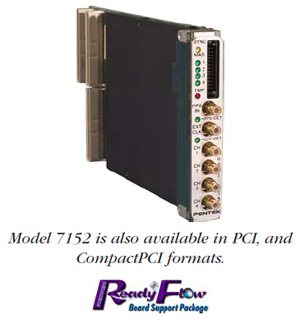|
Fall 2008 Vol. 17, No. 3
Model 7152 32-Channel Digital Downconverter with four 200 MHz, 16-bit A/Ds - PMC
Features
- 32 DDC channels in four banks of eight channels each
- Independent tuning for all channels
- Decimation from 16 to 8192
- Bandwidths from 20 kHz to 10 MHz
- Common decimation factor within each bank with different decimation factors between banks
- User-programmable 18-bit FIR filter coefficients
- Default filters with 0.2 dB ripple and 100 dB rejection
- Power meters and threshold detectors
- Clock/sync bus for multimodule synchronization
|

|
General Information
Model 7152 is a 4-channel, high-speed software radio module designed for processing baseband RF or IF signals from a communications receiver. It features four 200 MHz 16-bit A/Ds supported by a highperformance 32-channel installed DDC (digital downconverter) IP core and interfaces ideally matched to the requirements of real-time software radio and radar systems.
The front end accepts four full-scale analog RF or IF inputs on front panel SMC connectors at +8 dBm into 50 ohms with transformer coupling into four T I ADS5485 200 MHz, 16-bit A/D converters. The digital outputs are delivered into a Xilinx Virtex-5 FPGA for routing, formatting and DDC signal processing operations.
DDC Input Selection and Tuning
The Model 7152 employs an advanced FPGA-based digital downconverter engine consisting of four identical 8-channel DDC banks. Four independently controllable input multiplexers select one of the four A/Ds as the input source for each DDC bank. Many different configurations can be achieved including one A/D driving all 32 DDC channels and each of the four A/Ds driving its own DDC bank.
Each of the 32 DDCs has an independent 32-bit tuning frequency setting that ranges from DC to ƒs where ƒs is the A/D sample rate.
Decimation and Filtering
All of the 8 channels within a bank share a common decimation setting that can range from 16 to 8192, programmable in steps of 8. For example, with a sampling rate of 200 MHz, the available output bandwidths range from 19.53 kHz to 10.0 MHz. Each 8-channel bank can have its own unique decimation setting supporting four different output bandwidths for the board.
The decimating filter for each DDC bank accepts a unique set of user-supplied 18-bit coefficients. The 80% default filters deliver an output bandwidth of 0.8*ƒs/N, where N is the decimation setting. The rejection of adjacent-band components within the 80% output bandwidth is better than 100 dB.
Each DDC delivers a complex output stream consisting of 24-bit I + 24-bit Q samples at a rate of ƒs/N. Any number of channels can be enabled with each bank, selectable from 0 to 8. Each bank includes an output sample interleaver that delivers a channel-multiplexed stream for all enabled channels within the bank.
Power Meters, Threshold Detectors
The 7152 features 32 power meters that continuously measure the individual average power output of each of the 32 DDC channels. The time constant of the averaging interval for each meter is programmable up to 16K samples. In addition, 32 threshold detectors automatically send an interrupt to the processor if the average power level of any DDC falls below or exceeds a programmable threshold.
Output Multiplexers and FIFOs
Four output MUXs can be independently switched to deliver either A/D data or DDC data into each of the four output FIFOs. This allows users to view either the wideband A/D data or the narrowband DDC data.
Each of the output FIFOs operates at its own input rate and output rate to support different DDC decimation settings.
For more information and price quotation on the Model 7152, click here.
|